
Emblem |
Carpentras |
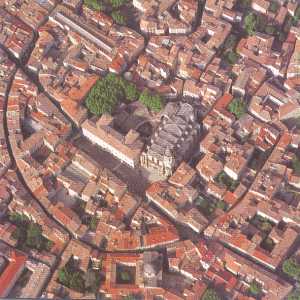 This pleasant market town, the seat of the
Comtat Venaissin, with its well-preserved ancient core has long been a trading centre. In the 5th century BC, it was
the capital of the Meminians, a celtic tribe. With navigational access to the Mediterranean via the Rhône and
the Auzon rivers, Greeks and Phonecians traded for corn, honey, sheep, goats, and hides.
This pleasant market town, the seat of the
Comtat Venaissin, with its well-preserved ancient core has long been a trading centre. In the 5th century BC, it was
the capital of the Meminians, a celtic tribe. With navigational access to the Mediterranean via the Rhône and
the Auzon rivers, Greeks and Phonecians traded for corn, honey, sheep, goats, and hides.
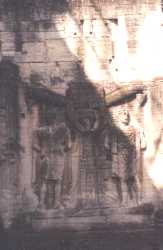 The Romans under Julius Cæsar conquered the region around 50BC, when the town was renamed Forum Neronis
after his lieutenant Neron.
Although mosaics and potteries have been excavated, the sole remaining visible remnant
of Roman times is a triumphal arch located behind the cathedral of St Siffrein with faded scenes depicting two
prisoners chained to a tree. Subsequently, the region was variously overrun by Burgundians, Ostrogoths and Franks,
a period of devastation through wars and pestilence.
The Romans under Julius Cæsar conquered the region around 50BC, when the town was renamed Forum Neronis
after his lieutenant Neron.
Although mosaics and potteries have been excavated, the sole remaining visible remnant
of Roman times is a triumphal arch located behind the cathedral of St Siffrein with faded scenes depicting two
prisoners chained to a tree. Subsequently, the region was variously overrun by Burgundians, Ostrogoths and Franks,
a period of devastation through wars and pestilence.
 The shaping of present-day Carpentras began in the 12th century with the partitioning of Provence, when the Count
of Toulouse received the Comtat Venaissin. At that time, temporal power was given to the bishop who made
Pernes-les-Fontaines its capital. In 1229, following the Albigensian Crusade, the Comtat became the property of the
Holy See, remaining so until the Revolution in 1791. Initially, the Count of Toulouse retained tenure until 1279.
The last Count, Alphonse de Poitiers, conferred a communal charter to Carpentras in 1269 though it was not until
1470 that a town hall was firmly estabished.
The shaping of present-day Carpentras began in the 12th century with the partitioning of Provence, when the Count
of Toulouse received the Comtat Venaissin. At that time, temporal power was given to the bishop who made
Pernes-les-Fontaines its capital. In 1229, following the Albigensian Crusade, the Comtat became the property of the
Holy See, remaining so until the Revolution in 1791. Initially, the Count of Toulouse retained tenure until 1279.
The last Count, Alphonse de Poitiers, conferred a communal charter to Carpentras in 1269 though it was not until
1470 that a town hall was firmly estabished.
 Most significant for Carpentras was the patronage of popes and cardinals. Pope Clement V visited the town from
1309 and settled there in 1313, though not for long - he died in 1314. Although the subsequent conclave took place
in the Episcopal Palace, the site of the present Law Courts, turmoil caused the cardinals to flee. The next Pope,
John XXII, was elected in Lyon though he soon transferred to Avignon. He established a permanent envoy in
Carpentras which became the capital of the Comtat Venaissin in 1320.
Under Innocent VI, the town prospered and
secondary, powerful ramparts were built with 32 towers and 4 gates. These were mostly demolished in the 19th
century. The impressive Porte d'Orange and some walls on either side are all that remains today.
Most significant for Carpentras was the patronage of popes and cardinals. Pope Clement V visited the town from
1309 and settled there in 1313, though not for long - he died in 1314. Although the subsequent conclave took place
in the Episcopal Palace, the site of the present Law Courts, turmoil caused the cardinals to flee. The next Pope,
John XXII, was elected in Lyon though he soon transferred to Avignon. He established a permanent envoy in
Carpentras which became the capital of the Comtat Venaissin in 1320.
Under Innocent VI, the town prospered and
secondary, powerful ramparts were built with 32 towers and 4 gates. These were mostly demolished in the 19th
century. The impressive Porte d'Orange and some walls on either side are all that remains today.
The papal territory provided relative sanctuary for Jewish people to escape the regular pograms associated with
the Crusades and unfriendly actions taken by kings of the French Kingdom such as Phillipe Le Bel. The ghetto that
was established by the 15th century persisted until the Revolution; by that time there were over 1000 people packed
into a street just 80m in length. The synagogue, the oldest that is still in use in the country, dates back to the
14th century.
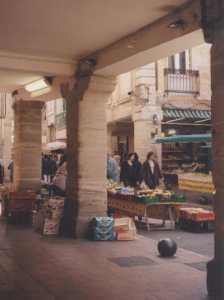
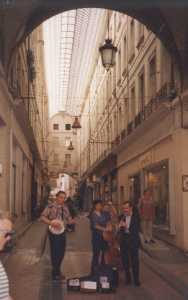 The 17th and 18th centuries marked a period of growth and prosperity, and with it the building of many fine
residences. In 1735, the Bishop Malachie d'Inguimbert founded the Hôtel Dieu, with its contemporary
apothecary still preserved, and also the famous Inguimbertian Library that now contains 100,000 antique volumes in
its collection of over 200,000, manuscripts, rich engravings and other artefacts of great value.
The 17th and 18th centuries marked a period of growth and prosperity, and with it the building of many fine
residences. In 1735, the Bishop Malachie d'Inguimbert founded the Hôtel Dieu, with its contemporary
apothecary still preserved, and also the famous Inguimbertian Library that now contains 100,000 antique volumes in
its collection of over 200,000, manuscripts, rich engravings and other artefacts of great value.
Irrigation resulting from the building of canals in the 19th century transformed the region into a fertile plain
in which early fruit and vegatables could be grown. With the coming of the railways, Carpentras became, and still
remains, an important agricultural centre.
Today, the old town is a colourful maze of small streets with the cathedral
of St Siffrein overlooking a large square at its centre, a place to relax at a café and watch the world go
by.
The Rue Des Halles just off the square has a collonaded, covered walk-way where fishmongers, vegetable sellers
and other vendors mount their stalls. Nearby is a covered archade of small shops built by the unemployed during the
Revolution.
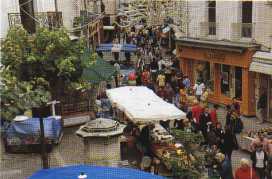 Every Friday morning, Carpentras hosts a huge market located in the Allées des Platanes and spreading
throughout the old town. Also, during the season from 27th November (opening with the impressive Foire St-Siffrein)
until March, a truffle market is held in the Place Aristide Briand opposite the Hôtel Dieu each Friday from
8-10am, one of the main markets for this sought-after fungus ("black gold") in France.
Every Friday morning, Carpentras hosts a huge market located in the Allées des Platanes and spreading
throughout the old town. Also, during the season from 27th November (opening with the impressive Foire St-Siffrein)
until March, a truffle market is held in the Place Aristide Briand opposite the Hôtel Dieu each Friday from
8-10am, one of the main markets for this sought-after fungus ("black gold") in France.
July is the month of "Les Estivales", a summer festival of music, dance, theatre and exhibitions.